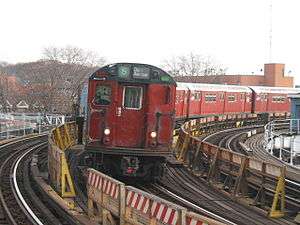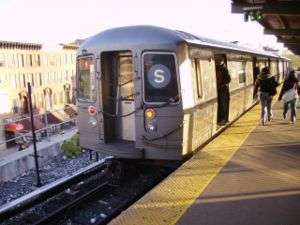R33 (New York City Subway car)
The R33 (Mainline) was a New York City Subway car that was built by St. Louis Car Company in 1962 and 1963. They are a "follow-up" or supplemental stock for the “A” Division’s R29s and closely resemble them. The cars were also referred to as R33MLs (R33 Main Line) to distinguish them from the R33WFs.
History
The first set of R33 cars was placed in service on the 1 train on November 15, 1962. Five hundred cars were built and served on all IRT subway lines.[1][2] In 1972 they became the first "A" division cars to be retrofitted with air conditioning, and by 1982 all R33 cars had received air conditioning. The cars were also rebuilt between 1986 and 1991.
Before they were rebuilt, the R33 cars were grouped as follows:
- Cars #8806–9075 had General Electric electrical equipment
- Cars #9076–9305 had Westinghouse electrical equipment
From 1987 until early 1991, the R33 cars were overhauled and rebuilt by the MTA's 207th Street and Coney Island Overhaul Shops. All cars were refitted with General Electric equipment. Existing General Electric cars received New York Air Brake Newtran brake packages; the former Westinghouse cars received an updated brake package from the Westinghouse Air Brake Company.
After rebuilding, R33 cars served on the 2, 4, and 5 trains, and occasionally on the 7 train.
Retirement
In 1996, New York City Transit announced that it would begin phasing out all Redbird cars – the R26, R28, R29, R33, and R36,[3] with the arrival of the R142 and R142A cars, which entered service in 2000. The final set of R33 MLs made its last trip on the 4 route on April 14, 2003.
Most of the retired cars were stripped and dumped into the Atlantic Ocean to form artificial reefs. However, many R33 cars were saved for various purposes throughout the New York City Subway system, including:
- 8885 – converted into a rail adhesion car for the IRT Dyre Avenue Line. The car is hauled by other cars during the fall season.
- 8912–8913 – used as a static display at the Tiffany Street Iron Shops, a training facility for elevated structure workers in Hunts Point, Bronx. This pair was previously involved in a derailment at the 239 Street Yard.
- 9010–9011, 9016–9017, 9068–9069 and 9206–9207 – repainted into various vintage paint schemes and used for various purposes since retirement (mostly on the Train of Many Colors).
- 9075 – used as a static tourist attraction at Queens Borough Hall in Kew Gardens, Queens. The car was retrofitted with swinging doors. Its future is uncertain as very few tourists visit the car.[4]
- 21 pairs were painted yellow and black and converted to work service as R161 rider cars RD400-RD441 from 1999 to 2004. RD407 (ex-8869) was damaged in a derailment and was scrapped in 2013. RD440-RD441 were further converted into de-icer cars.
Other cars were retained for work service until 2013, when they were scrapped, including:
- Pairs 8812–8813, 8834–8835, 8996–8997, and 9000–9001 – used as refuse storage cars until being scrapped in 2013. They were based from the 38th Street Yard. These cars were replaced with R32s restricted to work service.
- Pair 8888–8889 – used as a refuse train motor. It was based from the Westchester Yard, but in 2011 was mothballed when Westchester Yard stopped using subway cars for work service.
- Pair 9156–9157 – used for police training at Floyd Bennett Field until late 2013, when the pair was replaced by R110B 3001. The cars were moved to Linden Yard, and then up to the 207 Street Yard in 2014 for disposal.
Route assignments
| Routes | Years in Service | Cars |
|---|---|---|
| 1 | 1962 | All cars |
| 1, 2, 3, 4, 5, 6, 7 | 1963–1966 | All General Electric and Westinghouse cars |
| 2, 4, 5, 6 | 1966 | All cars |
| 2, 4, 5 | 1966–1985 | General Electric cars |
| 6 | 1966–1988 | Westinghouse cars |
| 3 | 1984–1986 | Some Westinghouse cars |
| 2, 5 | 1986–2002 | Most rebuilt cars |
| 4 | 1988–2003 | Some rebuilt cars |
| 7 | 1989–1996 | Some rebuilt cars |
Gallery
- Rollsign.
- Two different paint schemes that the R33 cars bore: kale green & Gunn red.
 Car 9075 on display at Queens Borough Hall.
Car 9075 on display at Queens Borough Hall. Car 9010 on the Train of Many Colors in 2008.
Car 9010 on the Train of Many Colors in 2008.
See also
References
| Wikimedia Commons has media related to R33 (New York City Subway car). |
- ↑ "www.nycsubway.org". www.nycsubway.org.
- ↑ "www.nycsubway.org". www.nycsubway.org.
- ↑ "NYC Transit prepared for major subway car procurement". Railway age. Simmons-Boardman Publishing Corporation. 1996-09-01. Retrieved 27 November 2009.
- ↑ Roberts, Georgett; Strum, Beckie (10 July 2015). "Queens tourist center closes because no tourist ever went there". New York Post.



